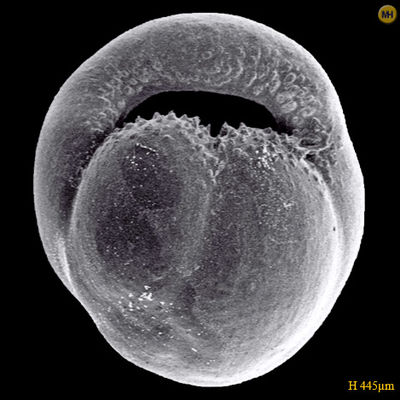Difference between revisions of "Pulleniatina obliquiloculata"
(add image) |
(Add info about this fantastic foram) |
||
| Line 5: | Line 5: | ||
[[File:P.Obliquiloculata.Picture.jpg | thumb| right |400px| Apertural view of a specimen of Pulleniatina obliquiloculata (Parker & Jones, 1862), in Hesemann, M. 2017 Foraminifera.eu Project Database.]] | [[File:P.Obliquiloculata.Picture.jpg | thumb| right |400px| Apertural view of a specimen of Pulleniatina obliquiloculata (Parker & Jones, 1862), in Hesemann, M. 2017 Foraminifera.eu Project Database.]] | ||
| − | '''Class'': Rotaliata '''Subclass''': Globigerinana '''Order''': Globorotaliida '''Family''': Pulleniatinidae | + | '''Class''': Rotaliata '''Subclass''': Globigerinana '''Order''': Globorotaliida '''Family''': Pulleniatinidae |
| + | |||
| + | ''Pulleniatina obliquiloculata'' is a warm-water planktonic foraminifer commonly found in upper [https://en.wikipedia.org/wiki/Thermocline thermocline] waters in tropical to subtropical regions <ref name=cleroux2007> Cleroux, C., Cortijo, E., Duplessy J.C., Zahn, R. (2007) Deep-dwelling foraminifera as thermocline temperature recorders. Geochemistry, Geophysics, Geosystems, 8, Q04N11 </ref> <ref name=wejnert2010> Wejnert K.E., Pride, C.J., Thunell, R.C. (2010) The oxygen isotope composition of panktonic foraminifera from the Guaymas Basin, Gulf of California: seasonal, annual, and interspecies variability. Marine Micropaleontology, 74, 29-37 </ref>. The calcification depth of ''P. obliquiloculata'' depends on its ontogenic life cycle with juveniles mainly confined to the mixed layer before migration at greater depth at the time of cortex formation <ref name=erez1981>Erez, J., Honjo, S. (1981) Comparison of the isotopic composition of planktonic foraminifera in plankton tows, sediment traps, and sediments. Palaeogeography, palaeoclimatology, palaeoecology, 33, 129-156. </ref> <ref name = hemleben1989> Hemleben, C., Spindler, M., Anderson, O.R. (1989) Modern Planktonic Foraminifera. Springer-Verlag, Berlin. </ref> <ref name=ravelo1992> Ravelo, A.C., Fairbanks, R.G. (1992). Oxygen isotopic composition of multiple species of planktonic foraminifera: recorders of the modern photic zone temperature gradient. Paleoceanography, 7 815-831. </ref>. This was demonstrated in a planktin tow study from the central equatorial Pacific where the largest abundance of adult speciments of ''P. obliquiloculata'' were found below 60m <ref name=watkins1996> Watkins, J.M., Mix, A.C., Wilson, J. (1996) Living planktonic foraminifera: tracers of circulation and productivity in the central equatorial Pacific. Deep Sea Research II, 43, 1257-1282. </ref>. ''P. obliquiloculata'' is found in greatest abundance along the seasonal [https://en.wikipedia.org/wiki/Thermocline thermocline]; in close association with the maximum in chlorophyll concentration <ref name=ravelo1992 />. Adult specimens of ''P. obliquiloculata'' can be easily identified from juveniles by the distinctive smooth outer cortex that envelops the final whorl in the adult, and an arched aperture <ref name=watkins1996 />. | ||
| + | |||
| + | |||
| + | ==References== | ||
| + | <references /> | ||
Latest revision as of 13:33, 9 May 2017
Class: Rotaliata Subclass: Globigerinana Order: Globorotaliida Family: Pulleniatinidae
Pulleniatina obliquiloculata is a warm-water planktonic foraminifer commonly found in upper thermocline waters in tropical to subtropical regions [1] [2]. The calcification depth of P. obliquiloculata depends on its ontogenic life cycle with juveniles mainly confined to the mixed layer before migration at greater depth at the time of cortex formation [3] [4] [5]. This was demonstrated in a planktin tow study from the central equatorial Pacific where the largest abundance of adult speciments of P. obliquiloculata were found below 60m [6]. P. obliquiloculata is found in greatest abundance along the seasonal thermocline; in close association with the maximum in chlorophyll concentration [5]. Adult specimens of P. obliquiloculata can be easily identified from juveniles by the distinctive smooth outer cortex that envelops the final whorl in the adult, and an arched aperture [6].
References
- ↑ Cleroux, C., Cortijo, E., Duplessy J.C., Zahn, R. (2007) Deep-dwelling foraminifera as thermocline temperature recorders. Geochemistry, Geophysics, Geosystems, 8, Q04N11
- ↑ Wejnert K.E., Pride, C.J., Thunell, R.C. (2010) The oxygen isotope composition of panktonic foraminifera from the Guaymas Basin, Gulf of California: seasonal, annual, and interspecies variability. Marine Micropaleontology, 74, 29-37
- ↑ Erez, J., Honjo, S. (1981) Comparison of the isotopic composition of planktonic foraminifera in plankton tows, sediment traps, and sediments. Palaeogeography, palaeoclimatology, palaeoecology, 33, 129-156.
- ↑ Hemleben, C., Spindler, M., Anderson, O.R. (1989) Modern Planktonic Foraminifera. Springer-Verlag, Berlin.
- ↑ 5.0 5.1 Ravelo, A.C., Fairbanks, R.G. (1992). Oxygen isotopic composition of multiple species of planktonic foraminifera: recorders of the modern photic zone temperature gradient. Paleoceanography, 7 815-831.
- ↑ 6.0 6.1 Watkins, J.M., Mix, A.C., Wilson, J. (1996) Living planktonic foraminifera: tracers of circulation and productivity in the central equatorial Pacific. Deep Sea Research II, 43, 1257-1282.
